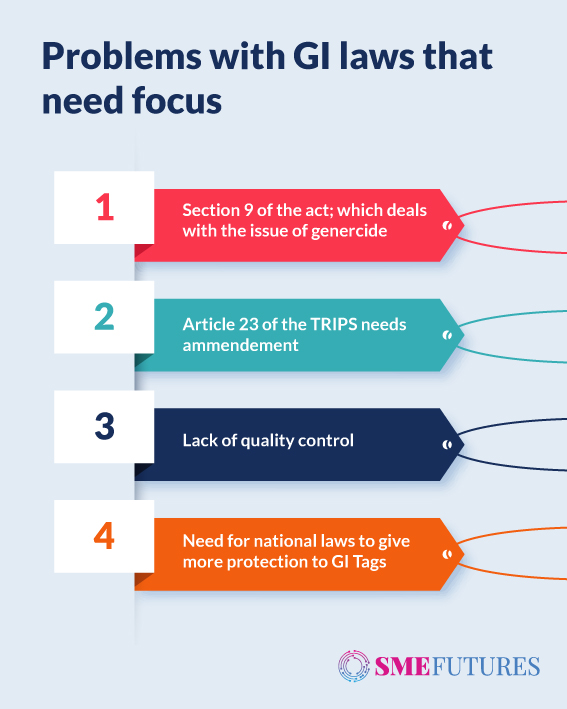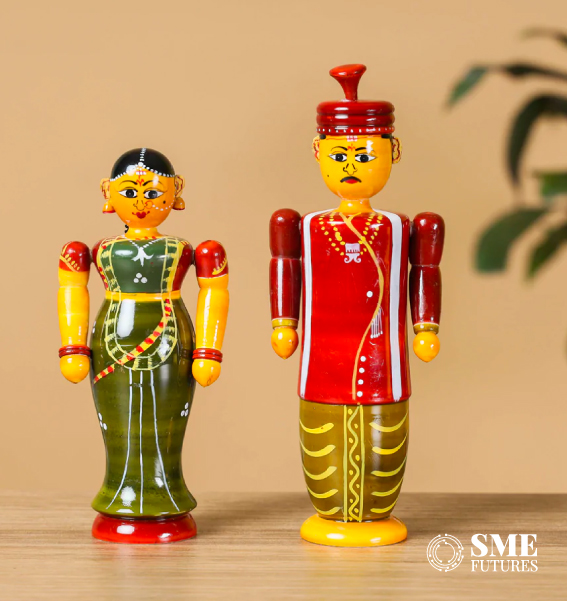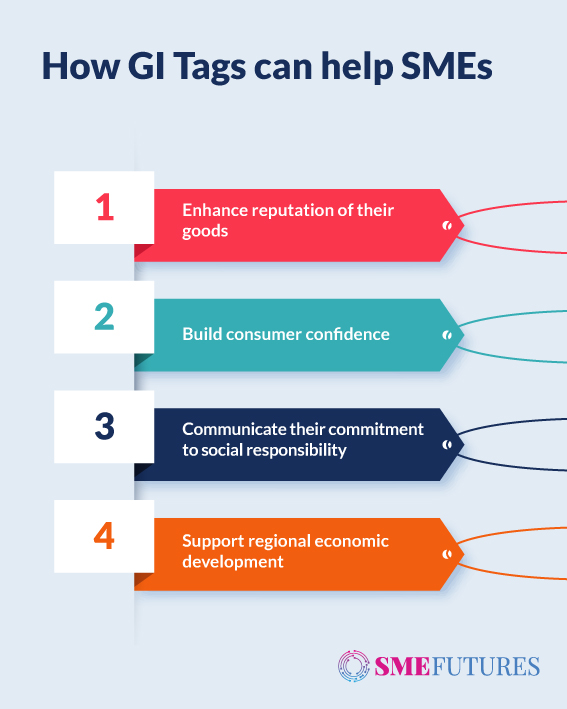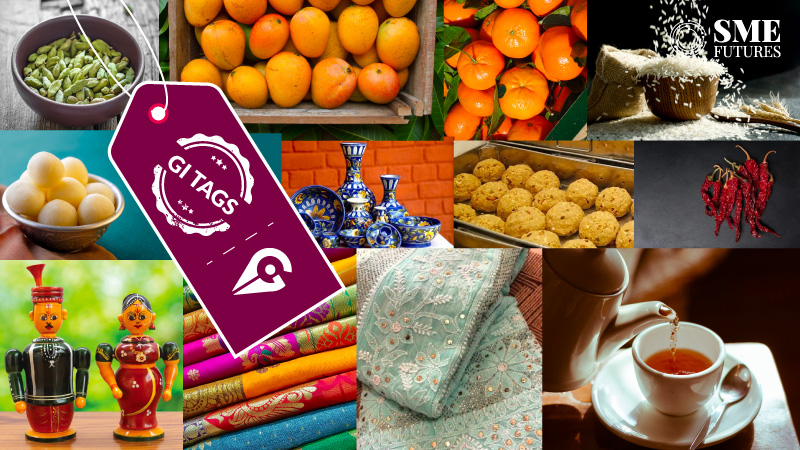Geographical Indication (GI) has come as a saviour for many farmers, traders and manufacturers. Under the Geographical Indications of Goods Act, 1999, farmers can now get tags – called geographical indication tag (GI tag) – for their products. These products have to be produced in a defined region and must possess some distinct qualities that help to differentiate them from similar products from a different region.
Mysore pak, Darjeeling tea, Basmati rice, Nagpur orange and Mysore silk are some of the products that have been granted GI tags. With the help of this tag, farmers and producers can now get their products marked as exclusive. This not only helps the farmers but also the consumers as they now have a tag of authenticity that they can trust without batting an eyelid.
Srutanjay Narayanan, an IAS officer, who is involved in raising awareness about GI tags, says that the GI tag, in essence, is a statutory legal IPR that a community gets for producing a product that is unique to its geography, which is both a social and cultural phenomenon. A product that is available only in that particular region.
The key word here is legal, which means that a particular community gets a right to that geographical location and nobody else can sell another product with the same name.
“For example, the Kovalpatti(peanut) kadalai mittai from Thoothukudi district in Tamil Nadu. If its name was to be used by someone who is not making it of the same quality, of the same type and by the same process which is registered in the GI registry, then a lawsuit can be filed to contest that. The government and the authorities are now focusing on the farmers and producers and are striving hard to enlighten them about GI tags: the ways in which they can be used and their various other benefits. If used well enough, GI tags can help boost a state’s or, at large, a country’s economy. GI tags hold immense potential and need to be further explored,” Narayanan tells us.
For some producers, GI tags have undoubtedly come in handy for securing exclusivity for their products, endowing their products with the right heft and authenticity. However, some others have argued that the laws are not specific enough and fake tags and products are not dealt with in the proper and stringent manner by the officials concerned.
Section 9 of the Geographical Indications of Goods Act, 1999, which deals with the issue of genericide, has also been too narrow in defining a product’s speciality and uniqueness.
The Indian laws regarding GI tags need to have more clarity as many farmers and producers continue to face problems even after clearing the process of registration.
Economic interests
The government and authorities alike are trying to make the farmers and producers more aware about the uniqueness and speciality of their products. The deft craftsmanship and incredible efforts that go into producing such products need to be acknowledged. Since the farmers and craftsmen’s original work and efforts get no recognition, they are slowly leaving their generations-old skills behind and shifting to daily wage work that will at least pay them on a daily basis.
Narayanan points this out, saying, ” A quality certifying authority is important to check the fake products. Blockchain technology can be used to ensure that fake products and organisations are not in the GI business. Each individual entity that is a part of a particular organisation must apply for an authorised user’s certificate from the GI registry in Chennai after getting an NOC from the association. There is lack of awareness about this.”
The authorised user’s certificate gives an entity the right to use the GI logo along with a unique registration ID, which the exporters and importers can check online. “The association has to be very proactive while following the registration process with the district administration to get the certificate. There are requirements of funding for the process to happen smoothly. There is a membership fee to join the association, but the smaller cottage industries may not be able to pay it,” he further adds.
Recently, to enable the formation of a GI ecosystem among the stakeholders, a conclave was organised by the NABARD Madurai Agribusiness Incubation Forum with the help of the Thoothukudi district administration.
In the meeting, it was discussed how over 300 GI tags had been provided all over the country. It was emphasised in the meeting that Tamil Nadu has only around 42 tags, even though there are far more products there that could be GI tagged.
The lack of information among the producers, artisans and farmers about the registration process, the post-GI schemes, the subsidies and about the process of filing an application for it are some of the reasons behind these low numbers.
The entry of India into the World Trade Organisation (WTO) has created an illusion of wealth and jobs in the country. The reality is just the opposite. The artisans and traditional arts are rapidly losing their foothold. These come at the bottom of the pyramid, including the MSMEs, which are also getting severely affected.
Some progress
The farmers have total control over their products with the GI tags, which can be renewed every 10 years. GI tags have helped boost the production of many products, which had lost their value or were on the verge of being pushed into oblivion.
For instance, Darjeeling tea has witnessed a five-fold increase in its domestic prices. The number of farmers cultivating Nagpur oranges has doubled over the last five years. Around 35,000 kg of Kovalpatti kadalai mittai is exported annually. These stats show that there has been an increase in rural migration and farming. The farmers, artisans and weavers are able to sustain themselves now that their products are being exported on a reasonably good scale.
Value creation through the GI logo

A logo was created in 2018 by the Department of Industrial Policy and Promotion (DIPP) with the tagline “Invaluable Treasures of Incredible India”. This has brought a new quality to the products. The GI logo can create a name and value of its own, which people can trust. India is a diverse country with a heritage that is thousands of years old. Each state and each region have something unique to offer, something which can be found nowhere else but at that particular location.
GI tags will help such communities to showcase their talent to the world. The recognition that a GI tag brings with itself holds a brand power that can be beneficial for many communities.
The farmers and artisans in India are not very aware as they are uneducated and poor, and to expect them to have knowledge about GI tags is too much to ask for.
It is the government, the NGOs and the educated people from within the community itself who can push the community members to acquire GI tags, by providing them with all the crucial information and by helping them through the tedious registration process.
GI tags can bring a lot of benefits for the producers and can help boost the economy of a region, clearing a path for the development and growth of the community that belongs to it.
In rural areas, the authorities should focus on providing more patronage to the art and culture of their communities. There should also be ample legal awareness regarding the laws.
The villages can build their own brand power through a GI logo which will authenticate their work. Take the case of the tequila manufactures in Mexico, one of the oldest GIs, which turned out to be hugely successful in creating a brand of its own.
Porous law
In India, producers face a lot of problem even after securing GIs, with fake products still rampantly being sold without any authenticity. Some argue that the laws are not effective enough to handle this as they are not thorough and are beset with loopholes. Some say that the policies for post-production support are not strict either.
Due to the lack of quality control on the free riders, such people within a collective group can lower the quality of a particular product. They take consumers for a ride if they are not aware of the distinction between a GI-tagged and non-GI tagged product.
To counter these ill practices, a separate group or inspection body should be formed to deal with such infringement cases and to book the perpetrators. This watchdog would regulate the process of acquiring the GI tags and help the authorities to have a better hold on the situation.

“GI-tagging has been done for some veggies and crops, but they are limited, more due to government restrictions. GI-tagging is denied by the government citing reasons that the people should be able to avail of at the right price. The reality is something else; these are to keep the big companies happy by keeping the prices minimal for their raw materials,” says Kalidas Apte, farmer activist, Shetkari Sanghatana.
“You will find a variety of fruits that grow in the hills of Maharashtra. Though they are rarely sold to the public. Instead, they are bought and used by the companies for their packaged drinks and other edible items, targeting the international market. In addition, they have built up many laws surrounding these fruits and veggies, making them more difficult to get GI-tagged. If the government focuses on these aspects and thinks about the development of the country’s farmers, then GI-tagging can be done on a larger scale,” he adds.
There are two parallels to this story. The good side of the story shows us the effectiveness of the law and GI tagging while the murky side points to the mismanagement and the lack of control in this arena as well as highlighting the lack of support for these marginalized communities.
Let’s have a look at the cases representing both sides of this story.
The case of Banarsi Sarees

Banarsi Sarees are very popular among celebrities and among the people in the fashion industry. They are highly priced assets and are well known around the world. However, even after getting the GI tag, this community is not getting even half the benefits and recognition that it should.
The problem is that there is a huge market that makes replicas of Banarsi Sarees, and this market is thriving on and cashing in on the age-old traditional art and work of this community. The Sarees’ fine silk and gold and silver embroidery enjoy a worldwide following but the deplorable condition of the community that makes it belies this fact.
The issue of the lack of quality control rears its head in most instances of GI certified products, with government officials not taking due measures to help out the communities which are facing an acute shortage of money, leaving them unable to sustain their families and themselves.
The case of Etikoppaka Toys

Etikoppaka toys are made in a small village by the same name, 64 kms away from the Vishakhapatnam district of Andhra Pradesh. These toys are made from wood and are distinct in the way that they are coloured: lacquer colours are made from the resinous secretions of insects and vegetable dyes via a process called oxidation.
The resulting lacquer colours are used to decorate the soft wood carvings. This art form has been in the community for generations and currently 150 households are involved in creating and sustaining it. Etikoppaka toys received its GI tag in 2017. The toys are also shipped out to be sold in the international markets.
“We acquired the GI tag in 2017 for Etikoppaka toys. The most important thing to have is the toxicology report to understand which parameters have been set by the Bureau of Indian Standards.
These are mostly necessary to sell the toys in the international market to meet the European and American standards. This has also helped in increasing the sales of the toys. Quality control should be handled at the ground level for which the Bureau of Indian Standards has set certain regulations and yardsticks, in order to maintain a uniformity of size, colour and dimension,” said CV Raju, an Etikoppaka toymaker from Andhra Pradesh.
Taking baby steps before the big leap
India has a long way to go in achieving GI tags for all its indigenous products and as time goes by there will be more pending GI applications. Narayanan underlines this fact, stating, “The government is working on a GI promotion cell which will be under the Ministry of Handicrafts and Handlooms to facilitate the various communities in boosting the economy.”
“The Agricultural and Processed Food Products Export Development Authority (APEDA) has an export promotion programme which supports GI products and gives incentives and subsidies to them. NABARD schemes also promote GI products. Besides that, the Spice Board of India has been giving a push to GI marketing. Countries like Germany, Italy and France have innumerable GI tags for their wines and champagnes,” he further adds.

Recently, India filed an application for the GI-tagging of its Basmati rice and has been facing a backlash from Pakistan for that, as it produces its own variety of Basmati rice. This shows that India is paying heed to the economic potential of a GI tag. In the international markets, the demand for Indian mangoes and other handicraft and art items is increasing and checks are being carried out by the government before the delivery of the shipments.
We see that there’s a lot of awareness to be raised among the farmers and producers, mostly in the rural areas. People like Kalidas Apte and CV Raju are motivating the people of their communities, and they are a shining example of how communities can explore and commercialize their traditional arts and handicrafts. Civil society organisations and YouTube influencers have a big role to play in raising awareness about the uniqueness of our products. India’s GI-tagged products will see a phenomenal rise soon and will play a vital role in shoring up the economy of the country.











